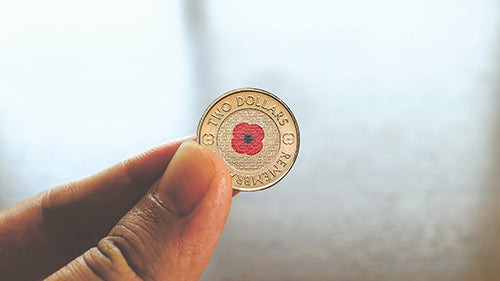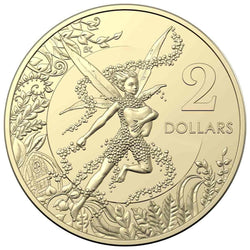Once upon a time, the $2 coin – along with the 5c and 10c coins – was almost entirely ignored by collectors. Australia’s obsession with ‘hoarding the commemorative’, a tradition that stretches back the predecimal era and the reign of King George V, ensured that these non-commemorative denominations received very little attention. Then, in 2012, the world turned upside down.
Colour $2 Coins – Australia’s hottest series!
It was in 2012 that the Royal Australian Mint struck Australia’s very first commemorative $2 circulation types – the 2012 Poppy $2 and 2012 Red Poppy $2. Crucially, the iconic 2012 Red Poppy $2 was Australia’s first full-colour circulating $2 coin.
This groundbreaking issue signalled a radical change in the nature of Australian commemorative coinage. While other denominations have largely been forgotten from a commemorative perspective, the 2012 Red Poppy $2 has been followed by a vast array of full-colour commemorative $2 coins. Consequently, the Royal Australian Mint’s colour $2 series has become the hottest in Australian numismatics. As far as what to look out for in your change, colour $2 coins is where it’s at!
Underpinned by bright, colourful designs and poignant, powerful themes, $2 coins stand out a mile in change. Commanding the attention of collector and non-collector alike as a result, every colour $2 is hoarded en masse. In addition, the colour $2 series is defined by tiny mintages. The average annual mintage of the $2 coin since introduced in 1988 is approximately 28 million, but take a look at the mintages of colour $2 coins!
The 2012 Red Poppy $2 had a mintage of just 500,000! The 2013 Coronation $2 had a mintage of just one million, and the 2015 Lest We Forget $2 had a mintage of just 1.46 million! Regarding more recent issues, the mintages have rarely been more than 2 million, and, compared to the annual average, that’s minuscule.
When you consider the low mintages, and that coins are issued into circulation across the country at random, depending on demand, it’s no surprise that all colour $2 issues are very tough-to-find in change – but that shouldn’t stop you from searching! Indeed, the hunt for $2 coins in change is one of the most challenging and therefore most enjoyable of modern numismatic pursuits, especially as the colour $2 series is well known for skyrocketing values.
With colour $2 coins consistently rising in value, and several worth hundreds of dollars, you should definitely keep your eye out for these little treasures. And colour $2 coins aren’t the only $2 coins worth searching for!
Not-issued-for-circulation types…
The Royal Australian Mint strikes coinage for Australia on the basis of demand, meaning that if there is no need for a particular denomination in a particular year, no coins will be struck. As far as the $2 denomination is concerned, and the standard Indigenous Elder type, there is only one date that was struck only for collectors – the 1991 $2. Only issued in 1991 Year Sets, the 1991 Indigenous Elder $2 should never be found in change – in theory at least. In reality, for whatever reason, it does turn up occasionally – and with a catalogue value of $40 in Uncirculated quality, it’s worth looking out for.
In the same vein, not-issued-for-circulation commemorative types are unlikely to be found in change – but they could be! Every one of the low-mintage Colour $2 C Mintmark issues, for
example, trades above the original issue price – many being worth hundreds of dollars. Struck from 2020 to 2023, and not issued for circulation, the RAM’s low-mintage Tooth Fairy $2
issues are also rising in value. The 2020 issue has a catalogue value of $350, with the 2021 ($95), 2022 ($70) and 2023 ($45) all worth well over issue price. Not-issued-for-circulation types do appear in change from time to time, so keep your eyes peeled.
Low mintage issues…
It is not only the Colour $2 Series that is notable for unusually low mintages – several of the Indigenous Elder $2 dates had very low mintages as well. The 1998 $2, for example, had a mintage of 8.7 million, and catalogues at $30 in Uncirculated condition. The 2000 $2 had a mintage of just 5.6 million, and catalogues at $60, with the 2011 $2 having a mintage of just 1.8 million and cataloguing at $35. The rising values of such coins in Unc are in part due to the fact that, as mentioned earlier, non-commemorative decimal types are often not set aside at issue, meaning only a small number survive in top grade.
Unique $2 Error types…
As with all decimal coinage, $2 Error types are very rare – largely as a result of the state-of-the-art equipment and rigorous quality control at the Royal Australian Mint. Mistakes do happen, however, and occasionally get through the system and into circulation. Off-centre strikes, double strikes, incorrect planchets, completely blank planchets, brockages – and more – Errors can be worth a lot of money, and represent a very good reason to keep a close eye on your change. This is exemplified by one Error type that is very particular to the $2 denomination – the $2 Bullseye!
Bullseye Errors – RAM misses the mark!
Appearing with the introduction of colour coins, the Bullseye $2 is a new member of the Error Family – and an extremely rare one! As a coin is struck before the application of colour, it is
possible, on very rare occasions, that it will be the wrong way around when the colour motif is applied. Thus, the colour is applied not to the reverse design, as it should be, but to the obverse, with the RAM scoring a ‘bullseye’ on the monarch’s portrait! This is now known as a Bullseye Error. A fascinating, rare, extremely valuable, and in some ways comical error, the existence of Bullseyes is a great reason to check your change. Most of the few known examples trade for thousands of dollars!
Time to check your change!
With the $2 series littered with key types and key dates, and notorious for rapidly rising market values, there is every reason you should keep an eagle eye on your change. Who knows what you might find? Good luck!



